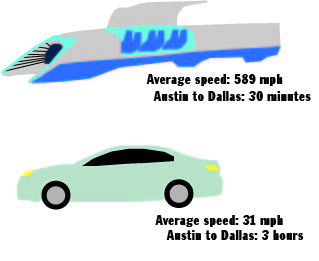One thing that Austinites have gotten used to is the disaster that is Interstate 35. Across the city, traffic is no longer “rush hour,” but “rush six-hours.” Studies have validated Austinites’ disdain for traffic through evidence that traffic has grown worse than any other metropolitan area in the last 20 years.
The cause for the increasing traffic is two-fold. First, Austin, an already densely populated college city and state capital, has become even more congested as job prospects within the thriving startup industry attract many from elsewhere. Second, Texas’ “pro-driving” culture means that with higher populations comes more vehicles on the road. In his State of the City Address in 2011, former Austin Mayor Lee Leffingwell addressed the problem of Austin’s traffic.
“Imagine your normal morning or afternoon commute, but with 500,000 additional cars on the road,” Leffingwell said. “That is our future — unless we take action now to change it. Austin’s traffic problems are the direct result of our dramatic, ongoing population growth, and our dramatic, ongoing failure to invest in the systems and infrastructure we need to stay ahead of it.”
Austin transportation culture is in dire need of savior. Enter the Hyperloop.
“The Hyperloop involves moving a pod resting on air bearings at nearly supersonic velocities through an evacuated tube,” Michael Rakavina, a mechanical engineering junior and the founder and captain of the 512 Hyperloop team, told The Daily Texan.
Rakavina and his team recently participated in design competition hosted by SpaceX, the private aerospace technology company. The UT team, along with 124 others, presented ideas that could revolutionize the nation’s transportation infrastructure. This technology could travel between Dallas and Austin in a span of just 30 minutes, a dream for any student that ever wanted to stay at home and commute to campus.
Austin’s traffic has been a growing issue for far too long and utilizing the Hyperloop, according to the CEO of SpaceX and man behind the idea, Elon Musk, can be the new mode of transportation that is both fast and inexpensive. The technology might cost less than high-speed rail, has a relatively low environmental impact and could travel up to 160 mph when full of passengers and 760 mph empty. These benefits could make possible previously unimaginable statewide transportation, and it’s something that Austin should invest in.
“It would mean you could be living in Austin and part of your daily work commute would be getting on Hyperloop and going to Houston,” Rukavina told KXAN.
Although the Hyperloop is now more of a possibility than pure theory, it won’t been seen until 2018. Various companies that are contributing to the project still have to answer a number of economic and technological problems, but it won’t be long until Austin finally receives the hero it needs, the hero it deserves.
Choudhury is an economics freshman from Dallas. Choudhury is a Senior Columnist. Follow him on Twitter @Mubarratc.





















